How to Structure Your E-commerce Facebook Ads Campaign

Hello, and welcome to Whiteboard Sessions. My name is Andrew Maff. And I am the founder and CEO of BlueTuskr, a full-service digital marketing company for e-commerce sellers. And today I'm going to go through exactly how we structure Facebook ad campaigns. And for those newbies out there, it's also Instagram ads.
What I'm gonna go through is how we structure them, I'm not going to go into what audiences we do, or how we figure out creative or anything along those lines. Because we're going to do that later, we do that in a different video. Today, we're gonna go real high level and just show you exactly how we structure these campaigns.
So we're gonna pretend and we're gonna did this in the last Google Ads a structure. So if you saw that when you know how I prefer to do these videos, but essentially, what I'm going to do is I'm going to kind of show you how I do this and presuming that we have like one product line. So if you have multiple product lines, you're going to want to just duplicate this process.
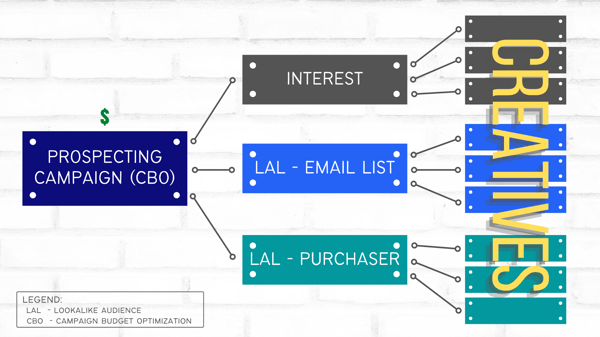
Prospecting Campaign - CBO
What we're going to do is we're going to start with one campaign, that's going to be basically a prospecting campaign, and we're going to do that probably is a CBO. So your campaign budget optimization, if you don't know what that means, that basically means that Facebook's going to take that budget that you're giving it and split it up amongst the entire campaign and all the ads, and he's just going to cater towards whichever ones doing the best, right? So then what we're going to do is we're actually going to take several different ad groups, right, or ad sets, I should say, and we're going to test a bunch of different audiences. And again, as I said, Don't know what your audience is yet, I'm going to show you that in a different video.
So we're just gonna pretend that you did some different audiences. So and again, also the iOS change a whole different story. So ignore that. So basically, what we're gonna do is, let's say, in this case, we're just testing three audiences. Given a budget, you want to test multiple audiences more than that, by all means, but so we're gonna pretend we're just testing three, due to iOS, some people are saying that the interest base is working better. So in this case, we're going to say that, you know, we're doing an interest-based audience, then maybe we're doing a look-alike of our email list. And then let's say maybe we're doing a look-alike of purchasers, right, like something super straightforward. And in this case, these are all 1%, right? So it's a 1% is probably where we'll start and then we'll open it up into two and three, and four, and etc.
So there have been some changes. So obviously, this comes down to like Facebook is such a fluid situation when you're running ads. So there are a couple of differences and how we would do this. But essentially, what we're going to do is we're going to try and separate out these different audiences to figure out which audiences working best for us.
In some cases, depending on how large these look like audiences are, you might actually not have a large enough audience base to run an ad and Facebook will tell you that you know, it's limited or something along those lines, a little white to yellow dot next, we'll show it but basically the limited and doesn't have enough data. So you might have to actually do what we refer to as stacking. So maybe we're going to combine these two audiences so that we have enough data that might happen, that might not happen, that's gonna be on a case by case.
What we're gonna do is we're gonna have this. And again, I'm not really going to get into ads, and creativity, and things like that on this video. However, what you should know is, the way that you tested this on Facebook is going to be very different depending on what you want your approach to be the way that we typically do it.
Since this is a testing ground that we're doing right here with this prospecting campaign, we're probably only going to test about two or three different pieces of creative, but that kind of again, depends on your budget if you have a large enough budget to be testing with, and you want to test a bunch of different pieces of creative by all means, but in the beginning, let's just say we're doing three, right we're gonna do three for each of these, they're gonna all be the same so that I can figure out which pieces of my creations are doing the best. And so that that way we can kind of figure it out from there. So these are we're gonna run this with all these three ad sets, right?
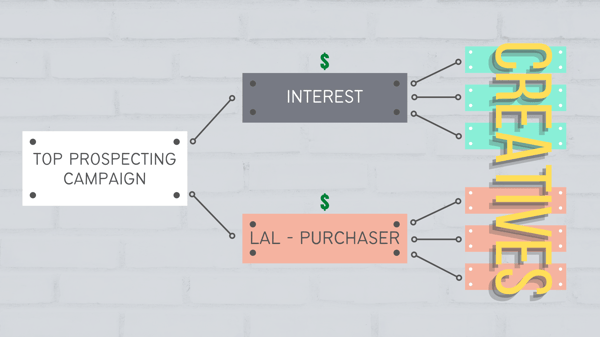
Top Prospecting Campaign
What we're gonna do now directly and create another campaign. And so this one let's call this one atop campaign, right? We did it Google ads, we can do it here if you want to call it a successful campaign. Or if you want to call it a holy crap AdWords campaign, I really don't care. But whatever it is, this is like your holy grail campaign where you're probably going to put a lot of your budget, let's just call this the top campaign.
Now, this is the dealer's choice on whether you want to do a CBO or if you want to do it actually by paying by ad set. So as I mentioned, for those of you who don't know the CBO campaign, your campaign budget optimization basically means I'm putting all of my budgets on the campaign and Facebook's going to split it out amongst these ad sets relatively evenly in the beginning, but once it starts to learn it's going to start to cater towards one or the other.
In this case, if you have let's say the look-alike purchasers did really well and look Let's say one has an interest that we did really well. So I'm going to actually take these out, and I'm going to negate them, I'm going to basically exclude them within these audiences so that I know I'm not doubling up on it. But I'm going to then move them here. So let's say now I have an interesting base here, right?
And now I have a look-alike. purchasers 1%. So this ad group, I'm sorry, this campaign, this testing ground, you kind of want to make a decision and make it fast. Because if you have a CBO, and you go great, this one's getting catered to, and it's doing well. Now I want to move it down here, get rid of it, so that Facebook can start and figure out which of these works best.
So usually, within about a week, maybe, depending on your product, depending on, you know, your category and things like that. Usually within about a week, maybe two weeks, you're going to go Okay, this one's definitely our best one right now. And then you get rid of it. Let that budget go towards the other things that you're testing. We're testing new things. And now we're going to move that down here. So we have this in our top campaign.
Now the question is, do we do it as a CBO? Or do we actually put our money directly into each ad group as opposed to the entire campaign as a whole, like I said, the dealer's choice, if you do a CBO, it's going to spread it evenly amongst these their work. But we already know this work. So the issue here now is that we already know these works. So why would I want to split my budget into these differently because Facebook's going to eventually cater to one? So you're gonna want to AV test this, typically what we end up doing is actually paying by ad group as opposed to campaign. So this is just going to be my top campaign. Again, this will be prospecting.
So basically, a new audience, right, so we're going to just call this top prospecting campaign. And then this one, I'm actually going to put my budget and split it evenly amongst each of these ad groups. So basically, that way, what's happening is, this is my campaign that houses all of my best audiences. But I'm going to just give a split share of my budget to each audience at least in the beginning, as time goes on, I might want to cater more towards to a budget my interest or more to a budget and in my look like purchasers whatever happens there.
Here is where I'm going to test some different things. So chances are in this one, let's say your look like a purchaser did well, there's a good chance that one of these ads is probably your best one that did well with that. So we're going to do is we're going to take these lookalike purchasers, and let's say this second ad with different creative and we move that down here. So now we only have one ad, but we only want to add that's not really testing and you should be testing at all times.
So what are we going to do here, we know this creative work. And we know that this copy worked. So now the question is, we pretty much narrowed down the creative because we tested three different creatives here, here, what we might do is just be consistently testing new copy, right? We know this one worked. So Facebook continues to cater to that one. And that one's doing well great.
But in the beginning, I might try be testing a couple of other different pieces of copy. Or I might create a more like responsible and put a bunch in there and let Facebook figure it out. So that's kind of again, users choice, you're going to have to basically just test it on an ongoing basis and figure it out from there. But similar to any kind of funnel structure, essentially what we're doing is figuring out which audience here and we're gonna narrow it down to our top audiences in this guy right here.
That's basically just having one testing audience down to one audience that we know is working. Now, as I mentioned, if you have a second product line or even multiple product lines, you might want to duplicate this because your audiences may be different. Maybe you want to look like a purchaser for a specific product line. Maybe you want to do a look alike of email lists for people who had purchased from a specific product line but also downloaded stuff for that specific product line or anything along those lines. Maybe the interest is different. A lot of things to consider. There is a lot of stuff to test audiences and all that or give me another video because that's going to take a little bit.
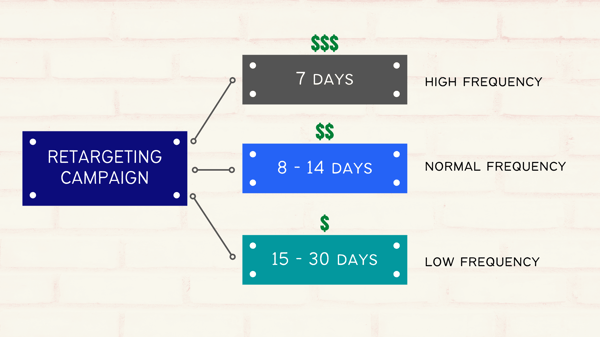
Retargeting Campaign
The next thing now is our retargeting and our abandoned cart. So let's talk about retargeting. So we're gonna have pretty much one retargeting campaign is my preference. And then we're just going to go straight ads. So let's call this, you know a retargeting campaign. And I actually kind of prefer to do this one straight at putting the money into each ad group, as opposed to as a CBO. And the only reason I say that is because what I want to do is I actually want to break this down by what I figured out my sales cycle is.
So, you're gonna want to go into the back end of whatever platform you're on looking to Google Analytics and really dig into. Once someone lands on our site, how long does it take them? How long does it take them to convert, right? So if you have a very short sale cycle where nine times out of 10. They purchase within two days, well, then you're gonna want this first ad group to be basically, let's say, five to seven days. So you're gonna want to target let's say, seven days.
So we can do a clean week in this scenario, but you're going to want to target everyone who has visited your site in the past seven days and didn't convert because basically, this is going to be a majority of your audience, you're going to want a majority of your buddy To go here, right? So that way, you know, you're probably going to want this frequency to be a little bit higher too because you want to stay in front of them a lot.
Now this one we're going to do, let's say 14 days, right, so we're going to do eight to 14 days, and we're going to pull it a little bit less budget here, and we're gonna want the frequency and be a little normal here, normal to me, I try to say like three to four times a week. But again, it's going to be depending on your product line, and you start to learn how to brand awareness. You really need to have sometimes, as we've worked with coffee brands, they need a lot higher frequency than your average, you know, e-commerce seller who might just be selling something, you know, like a marker, which I'd seem to use a lot of.
But now you got to think so this is everyone who is not who's come to the site and didn't purchase within eight to 14 days, right. So now we have the budget a little bit lower, we have the frequency, we're probably going to average like something normal. And then this one we're going to do again, it's going to be depending on your life cycle, maybe you want to do 15 to 30 days, maybe you want to do more and to 14 to 21, and then 21 to so on. Like you can basically break this down however you choose.
Typically after about 30 days, you start to risk really pissing people off, because you're following them everywhere for a very long time. And in this case, I'm definitely using less of a budget, and I'm keeping my frequency a little bit lower than usual, this is just a Hey, we're still here, don't forget, and you know, you might get some of those stragglers, but I'm not really betting on this one. So I'm not going to put too much of my budget there.
So these will all be your stereotypical, like, you know, we'll do different creative, we'll do different copy, we're going to test different ones as time goes on. But definitely want to make sure we're testing, you know, primarily video is obviously the goal, if you can't have it, maybe cater to a carousel, so it's a little more interactive. And then if you're stuck with a static image, so such as life sometimes. But basically, we're going to test all those here, but I'm going to keep all these basically separated.
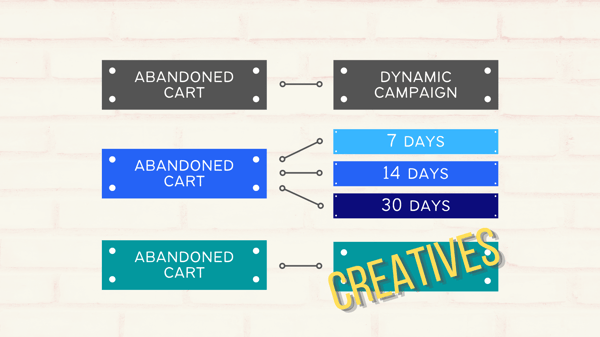
Abandoned Cart
Now, the other side of this, too, is to consider an abandoned cart or mini cart, we're gonna have to set it up as a different campaign. And the reason I suggest setting this up as a different campaign is these people are very more likely to convert, right, they added it to their cart, they were basically ready to go, they were on their way, and then they stopped.
So we're going to want to put a pretty good amount of budget here. However, I know that we're going to do with this one is going to be a dynamic campaign. So basically what a dynamic campaign is if you're not sure what that is, is basically you connect your catalog from whatever platform you're using directly into Facebook, and then you're going to just show it's going to automatically show whatever the product is that they left in their cart, or maybe a product also that they saw and didn't add to their cart or something, but it's going to show products that that's very specific to them.
So this one, I'm going to want to have a pretty significant budget for it to actually cater towards showing them exactly what they left behind, or copy you know, depending on your brand, avoid to be something like hey, come finish the job or something like that. But I'm going to put a decent amount of budget towards this. So this is going to be a dynamic campaign.
Currently in Facebook, at least as of this video, right now, you can't do a dynamic campaign and also doing like your average creative like a video or a carousel or something. So you might within your retargeting campaign also want to have another abandoned cart that's a little bit more catered towards, you know, the creative if you want it to have a, you know, obviously much more of a custom vibe. And maybe you can personalize a little bit more.
Or what you can do is create yet another abandoned cart campaign that's not dynamic. And do the same thing here where you have the abandoned cart seven days ago, eight to 14 days ago, 15 to 30 days ago. And then again, depending on your product line, depending on your brand, if you're okay with offering a sale, maybe you want to offer like hey, for this first seven days, just a reminder, like hey, you left the cart, please come back eight to 14 days be like, Hey, here's 5% off, now we're down to 10% off, and then it's going to be up to you on how far you want to tear that down.
But essentially what's happening here, right is we're prospecting, kind of send them all to the websites, we're just gonna pretend this is the website, this is gonna get really messy here. So, prospecting was sent to the website, maybe it didn't work, that's fine, we're going to retarget them for seven to 14 to 31 days. And then you know, now we've catered though, we figured out exactly who our audiences are setting them to the site, we know they're going to work well.
But again, we're gonna retarget them just in case they don't. And then for everyone who added to the cart, and we're like, yeah, they're doing well we're sending them directly back to so this is basically how we structure these Facebook ad campaigns. A large change with Facebook ads recently, a lot is different. Again, depending on your product line, your category your owner, because it's obviously going to be dependent on what your overall goals are with the business.
This is usually how we start off structuring a Facebook ad campaign. We're going to get deeper into another video about what types of audiences to test you know, different interest-based audiences different lookalike audiences when to get into one and two and 3% and so on. We're gonna do that in another video. But for now, I just wanted to show you all exactly how on a high-level structure with a little bit more visualization here about how we structure these Facebook ads.
That's all I have for today. So obviously really appreciate everyone tuning in. If you have any questions or you have a specific product line, you're not sure if this is going to work, just comment and I will make sure that I get into it and let you guys know exactly what I would suggest for someone from my team well, and then of course, if there's a video that you want us all to cover that you would like to some more insight on more than happy to do that.
So just make sure you guys comment below and of course rate review, subscribe, and all that fun stuff that every YouTube channel says. But appreciate it all. And if you have any questions, feel free to comment and we'll make sure to get to it. Okay, thanks.

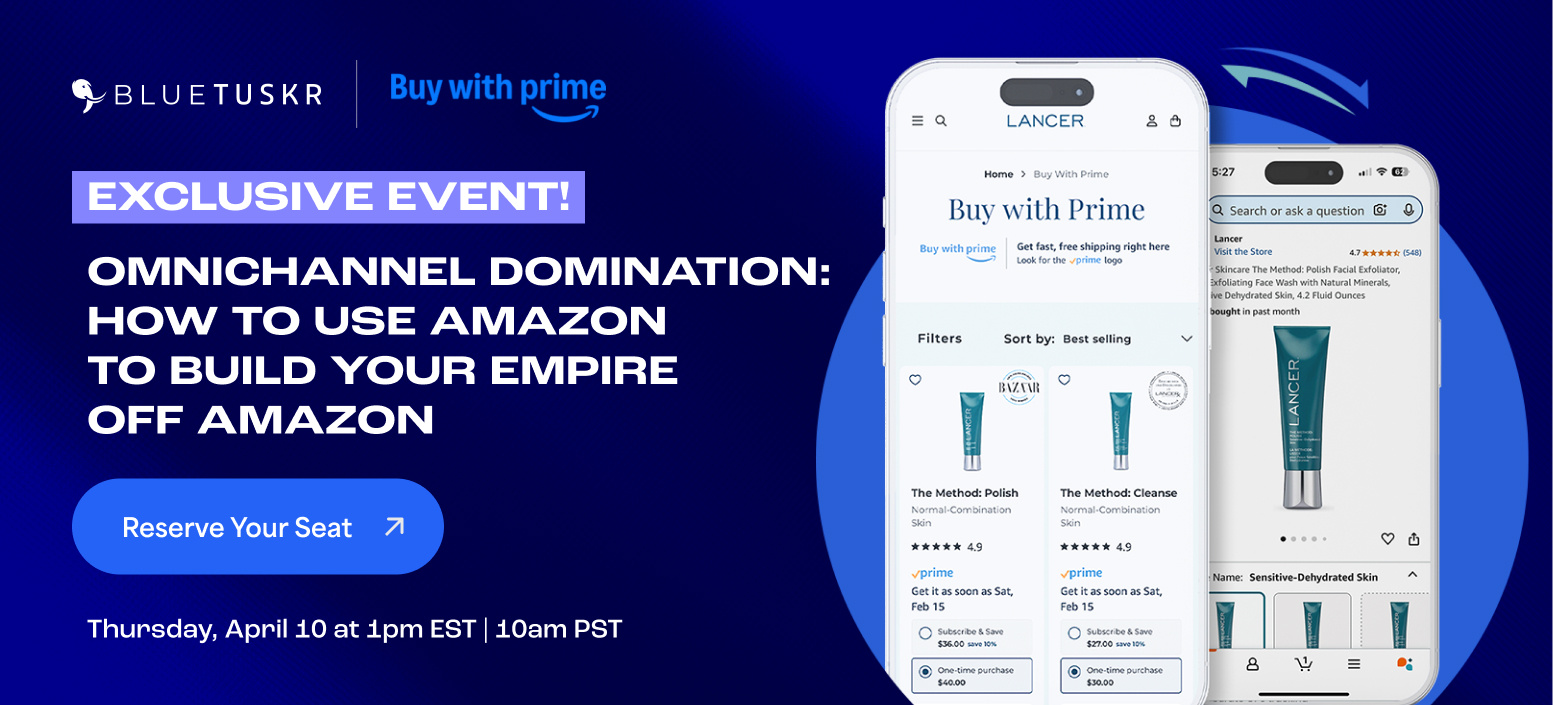


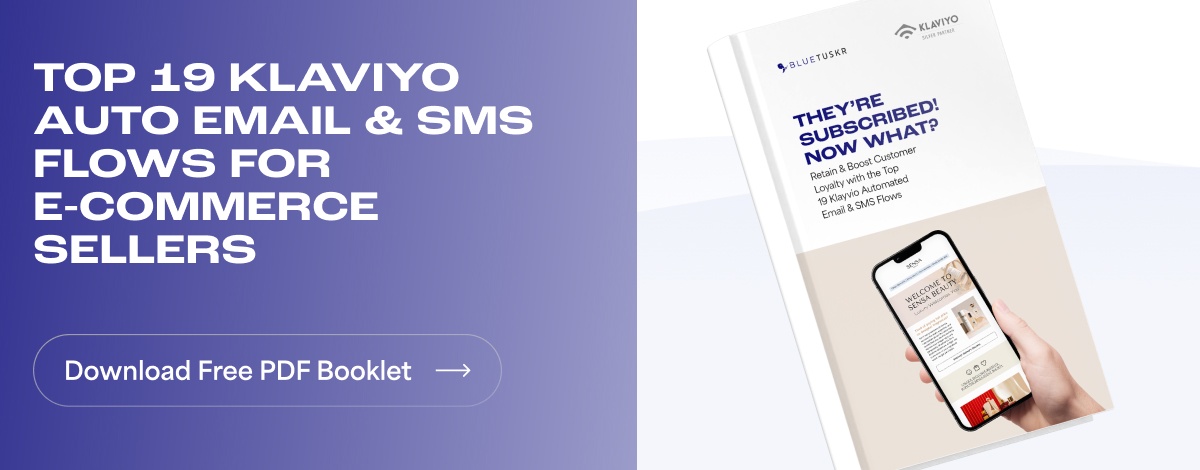



Leave a Reply